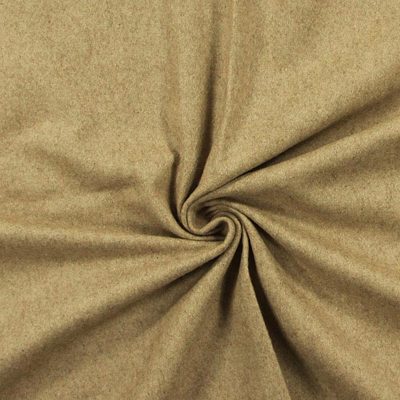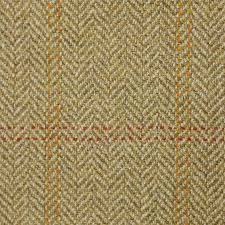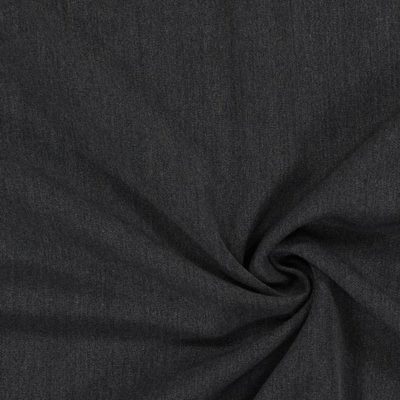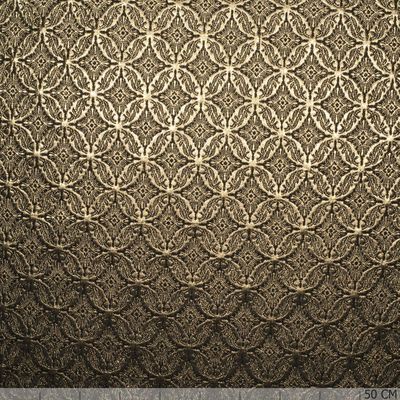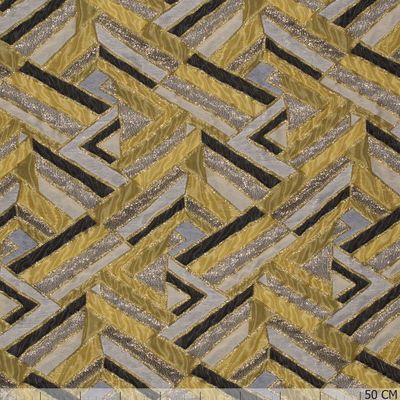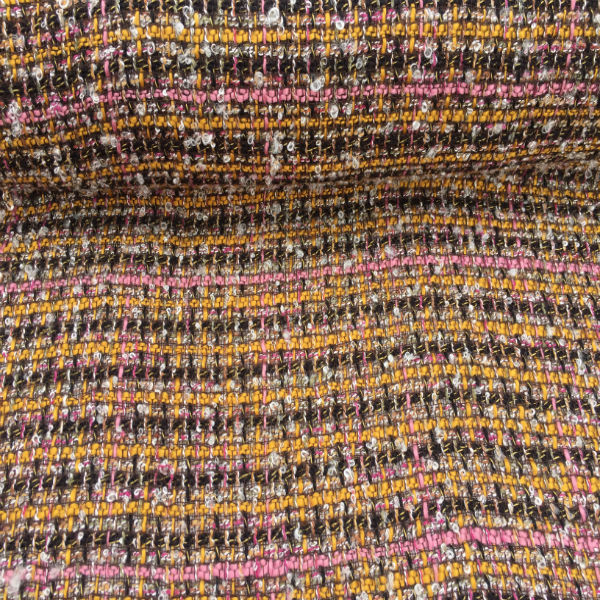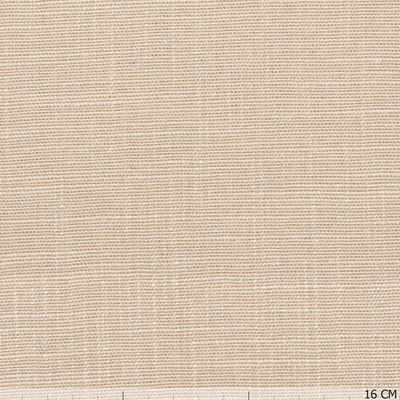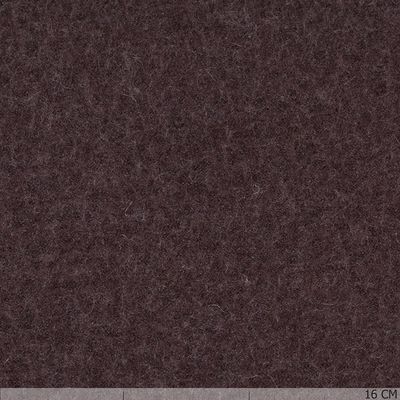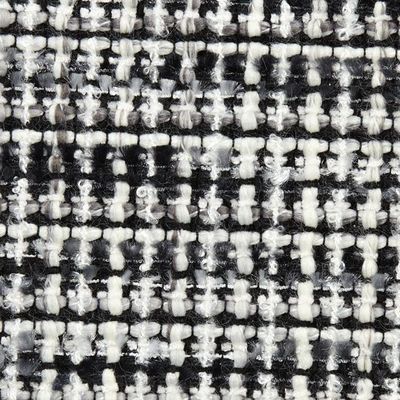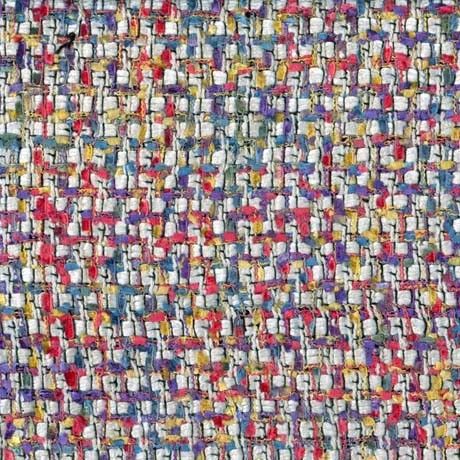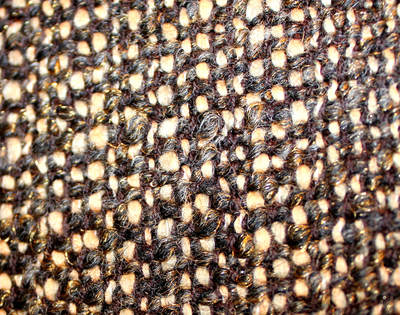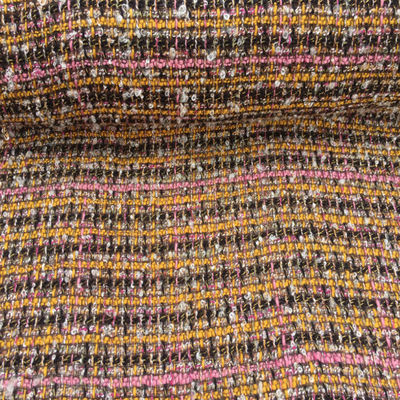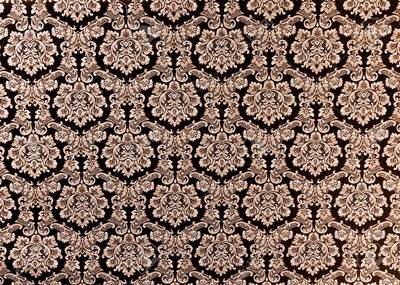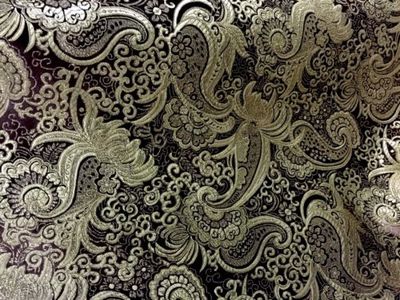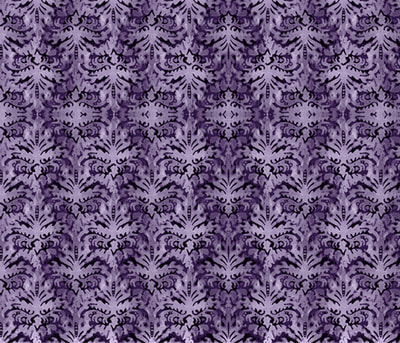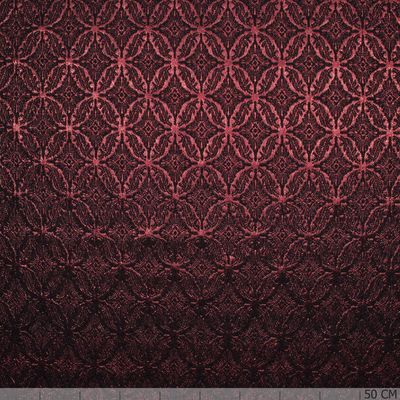How to choose the right fabric?
First of all: Take a look at all the Fantastic Fabrics.
Surely you have your own taste and favourites.
Do you like the bold or the uni-colours?
Do you like the golden or silver threads in it?
Do you like the decent tweeds or the crazy bouclé fabrics?
Do you like the graphic designs or no designs at all?
Do you like the firm heavy-weight or the feather light-weight fabrics?
Which colours suits you most?
Which colours are best to match your other clothes?
Is the jacket for a particular event or are you going to wear it casual daily?
A lot to consider. But more important: what does the sewing pattern require? Fabrics are always mentioned on the back of the envelop or inside the sewing pattern papers. These requirements are very important. If you have enough experience with the model, you can go your own way. But if you sew the model/pattern for the first time; it is wise to stick to the advised requirements about the fabrics.
First of all: Take a look at all the Fantastic Fabrics.
Surely you have your own taste and favourites.
Do you like the bold or the uni-colours?
Do you like the golden or silver threads in it?
Do you like the decent tweeds or the crazy bouclé fabrics?
Do you like the graphic designs or no designs at all?
Do you like the firm heavy-weight or the feather light-weight fabrics?
Which colours suits you most?
Which colours are best to match your other clothes?
Is the jacket for a particular event or are you going to wear it casual daily?
A lot to consider. But more important: what does the sewing pattern require? Fabrics are always mentioned on the back of the envelop or inside the sewing pattern papers. These requirements are very important. If you have enough experience with the model, you can go your own way. But if you sew the model/pattern for the first time; it is wise to stick to the advised requirements about the fabrics.
* Disclaimer: Some photos are not taken or owned by me. They are used solely for the purpose of discussion, comment and as a visual aide to convey the beauty of the object to you, the viewer. These images are not intended for any commercial purpose.
Some tips about the requirements on the sewing patterns:
Wool and Wool blends - 100% wool fabrics are expensive. Wool blends are usually a bit cheaper and sometimes very good as well. Wool is the textile fiber obtained from sheep and other animals, including cashmere and mohair from goats, qiviut from muskoxen, angora from rabbits, and other types of wool from camelids. Wool mainly consists of protein together with a few percent lipids. In this regard it is chemically quite distinct from the more dominant textile, cotton, which is mainly cellulose. Wool is considered by the medical profession to be allergenic. Wool fibers readily absorb moisture, but are not hollow. Wool can absorb almost one-third of its own weight in water.
Wool or wool blends are not easy to clean. Dry-clean is the best option.
Sewing with wool or woolblends is very nice. If you are a beginner; stick to the light-weight wool. If you are an advanced seamstress; cashmere will be a challenge and walkloden will be paradise. Walkloden coats and jackets are timeless beautiful and sophisticated. Walkloden jackets are not meant to be outdoors, sadly because the warmth is a fact. But as said: wool absords water and is not suitable for rainy situations.
Tweeds - Tweeds are beautiful and easy to wear but it all depends on the styling and finishing of the garment. Tweed-look happens to be a bit old-fashioned as well because most tweeds are based on brown colours. Beige, brown, green and herringbone or pied de Poule designs, are beautiful and very classic but you probably do not want to look "Downton Abbey-like".......... but more from this century. Also be careful to choose a nice colour which has not too masculine appearance; try to find some modern colours and radiant designs. They are out there, and once you have found a suitable tweed, you will love to sew with it and love to wear it.
Sewing Tweeds is great work. Although it can be tricky because of its loose threads, it folds easily and it feels like heaven. If you buy a herringbone tweed; practise and practise. It will not be easy to work on the darts, the seams and get it visually perfect.
Bouclé - Bouclé fabrics are Beautiful with Capitals. The fabric is both a yarn and a fabric at the same time. The yarn is made from a length of loops of similar size which can range from tiny circlets to large curls. To make bouclé, at least two strands are combined, with the tension on one strand being much looser than the other as it is being plied, with the loose strand forming the loops and the other strand as the anchor. Bouclé is also the name of the fabric made from this type of yarn, especially fabric that maintains the looped appearance.
Bouclé has a striking appearance as it sometimes even contains golden threads or silver threads. Colours can be pretty wild as well and very modern.
It will not be easy to sew with bouclé fabrics. The threads happens to be loose or very loose and and therefore they easily fray. Before you know it, you have a tuft of threads in your hands which can be very frustrating. Buy some extra centimetres fabric and practice a bit. Practice especially if you want to quilt the fabric and go for a good lining. About lining here more information.
Wool and Wool blends - 100% wool fabrics are expensive. Wool blends are usually a bit cheaper and sometimes very good as well. Wool is the textile fiber obtained from sheep and other animals, including cashmere and mohair from goats, qiviut from muskoxen, angora from rabbits, and other types of wool from camelids. Wool mainly consists of protein together with a few percent lipids. In this regard it is chemically quite distinct from the more dominant textile, cotton, which is mainly cellulose. Wool is considered by the medical profession to be allergenic. Wool fibers readily absorb moisture, but are not hollow. Wool can absorb almost one-third of its own weight in water.
Wool or wool blends are not easy to clean. Dry-clean is the best option.
Sewing with wool or woolblends is very nice. If you are a beginner; stick to the light-weight wool. If you are an advanced seamstress; cashmere will be a challenge and walkloden will be paradise. Walkloden coats and jackets are timeless beautiful and sophisticated. Walkloden jackets are not meant to be outdoors, sadly because the warmth is a fact. But as said: wool absords water and is not suitable for rainy situations.
Tweeds - Tweeds are beautiful and easy to wear but it all depends on the styling and finishing of the garment. Tweed-look happens to be a bit old-fashioned as well because most tweeds are based on brown colours. Beige, brown, green and herringbone or pied de Poule designs, are beautiful and very classic but you probably do not want to look "Downton Abbey-like".......... but more from this century. Also be careful to choose a nice colour which has not too masculine appearance; try to find some modern colours and radiant designs. They are out there, and once you have found a suitable tweed, you will love to sew with it and love to wear it.
Sewing Tweeds is great work. Although it can be tricky because of its loose threads, it folds easily and it feels like heaven. If you buy a herringbone tweed; practise and practise. It will not be easy to work on the darts, the seams and get it visually perfect.
Bouclé - Bouclé fabrics are Beautiful with Capitals. The fabric is both a yarn and a fabric at the same time. The yarn is made from a length of loops of similar size which can range from tiny circlets to large curls. To make bouclé, at least two strands are combined, with the tension on one strand being much looser than the other as it is being plied, with the loose strand forming the loops and the other strand as the anchor. Bouclé is also the name of the fabric made from this type of yarn, especially fabric that maintains the looped appearance.
Bouclé has a striking appearance as it sometimes even contains golden threads or silver threads. Colours can be pretty wild as well and very modern.
It will not be easy to sew with bouclé fabrics. The threads happens to be loose or very loose and and therefore they easily fray. Before you know it, you have a tuft of threads in your hands which can be very frustrating. Buy some extra centimetres fabric and practice a bit. Practice especially if you want to quilt the fabric and go for a good lining. About lining here more information.
An other word about Bouclé -Buy some extra fabric ! It will be awesome to create fringes yourself from the same fabric as the jacket is going to be. It takes a lot of practice but there are some nice video's with good instructions about creating and even designing ingenious fringes yourself.
Also do not forget to take a look at the book: Making Designer trims. It will be worth a lot to create those fringes yourself from the same fabric. If you have the time and are willing to make something very special and personal: crochet a nice edge of the tattered bouclé fabric.
We will get back on this one.
Also do not forget to take a look at the book: Making Designer trims. It will be worth a lot to create those fringes yourself from the same fabric. If you have the time and are willing to make something very special and personal: crochet a nice edge of the tattered bouclé fabric.
We will get back on this one.
Garbadine - Garbadine fabric is a tough, tightly woven fabric used to make suits, overcoats, trousers, uniforms, windbreakers and other garments. Cotton gabardine is often used by bespoke tailors to make pocket linings for business suits, where the pockets' contents would quickly wear holes in the usual flimsy pocket lining material. Clothing made from gabardine is generally labelled as being suitable for dry cleaning only, as is typical for wool textiles. Gabardine may also refer to the twill-weave used for gabardine fabric, or to a raincoat made of this fabric.
"Normal Garbadine" is perfect and easy to work with. But for a Chanel Inspired jacket ? A bit boring. Unless you are focussing on the bands, lining, fringes etc. A good example: Vogue V9095.
Garbadine as mostly uni-colours but maybe a great idea to buy a Garbadine with a design or daring pattern?
Read the labels (if they are still on the fabric). Garbadine might have some stretch in it. In the length or wide-stretch. It sounds comfortable to have a bit of stretch in it, but the sewing-process will be different and you have to find a stretchy lining as well. Best to stick to the not-stretch Garbadine, it will be less frustrating and look better in the end.
Linen - Great choice for summer clothes. Very nice to work with and easy to wear. Cool in Summer and even though it wrinkles like hell; it always looks sophisticated. Linen fabric has been used for table coverings, bed coverings and clothing for centuries. The significant cost of linen derives not only from the difficulty of working with the thread, but also because the flax plant itself requires a great deal of attention. In addition flax thread is not elastic, and therefore it is difficult to weave without breaking threads. Thus linen is considerably more expensive to manufacture than cotton. In other words: Linen is expensive. But worth it !
Try to find a matching lining or better: no lining at all. Cleaning and ironing will be much easier.
Jacquard or Brocade - Brocade or Jacquard fabric is a class of richly decorative shuttle-woven fabrics, often made in coloured silks and with or without gold and silver threads. Brocade and jacquard are mostly mentioned under the same category on fabric-stores because there are very suitable for events, gala's, wedding-days , special occasions. They are also used for party clothes and formal events. Mostly because of its gold and silver-look and luxurious appearance. Something special !
Most fabrics are not stretchy and not so easy to wear. But who cares? A Chanel Inspired jacket made of brocade or jacquard will be something special anyway!
If the fabric is outstandingly regal or striking, combine it with an uni-color lining and hold back on the lining, fringes etc. You do not want to look like a drag-queen in the tacky meaning of the word.
Because of its boldly appearance we would love to advise to take a close look at the sewing patterns. The very short jackets will be very nice in these glamour fabrics. The longer jackets and the loose-fitting jackets might be "too much" created in these fabrics.
"Normal Garbadine" is perfect and easy to work with. But for a Chanel Inspired jacket ? A bit boring. Unless you are focussing on the bands, lining, fringes etc. A good example: Vogue V9095.
Garbadine as mostly uni-colours but maybe a great idea to buy a Garbadine with a design or daring pattern?
Read the labels (if they are still on the fabric). Garbadine might have some stretch in it. In the length or wide-stretch. It sounds comfortable to have a bit of stretch in it, but the sewing-process will be different and you have to find a stretchy lining as well. Best to stick to the not-stretch Garbadine, it will be less frustrating and look better in the end.
Linen - Great choice for summer clothes. Very nice to work with and easy to wear. Cool in Summer and even though it wrinkles like hell; it always looks sophisticated. Linen fabric has been used for table coverings, bed coverings and clothing for centuries. The significant cost of linen derives not only from the difficulty of working with the thread, but also because the flax plant itself requires a great deal of attention. In addition flax thread is not elastic, and therefore it is difficult to weave without breaking threads. Thus linen is considerably more expensive to manufacture than cotton. In other words: Linen is expensive. But worth it !
Try to find a matching lining or better: no lining at all. Cleaning and ironing will be much easier.
Jacquard or Brocade - Brocade or Jacquard fabric is a class of richly decorative shuttle-woven fabrics, often made in coloured silks and with or without gold and silver threads. Brocade and jacquard are mostly mentioned under the same category on fabric-stores because there are very suitable for events, gala's, wedding-days , special occasions. They are also used for party clothes and formal events. Mostly because of its gold and silver-look and luxurious appearance. Something special !
Most fabrics are not stretchy and not so easy to wear. But who cares? A Chanel Inspired jacket made of brocade or jacquard will be something special anyway!
If the fabric is outstandingly regal or striking, combine it with an uni-color lining and hold back on the lining, fringes etc. You do not want to look like a drag-queen in the tacky meaning of the word.
Because of its boldly appearance we would love to advise to take a close look at the sewing patterns. The very short jackets will be very nice in these glamour fabrics. The longer jackets and the loose-fitting jackets might be "too much" created in these fabrics.
More information:
For inspiration: Fantastic Fabrics, Trims & fringes, those beautiful buttons
Cleaning and Caring: How to clean and care for your fabrics
Matching Lining: How to choose the right lining ?
Cleaning and Caring: How to clean and care for your fabrics
Matching Lining: How to choose the right lining ?
Were to buy? On a Fabric-Event !
